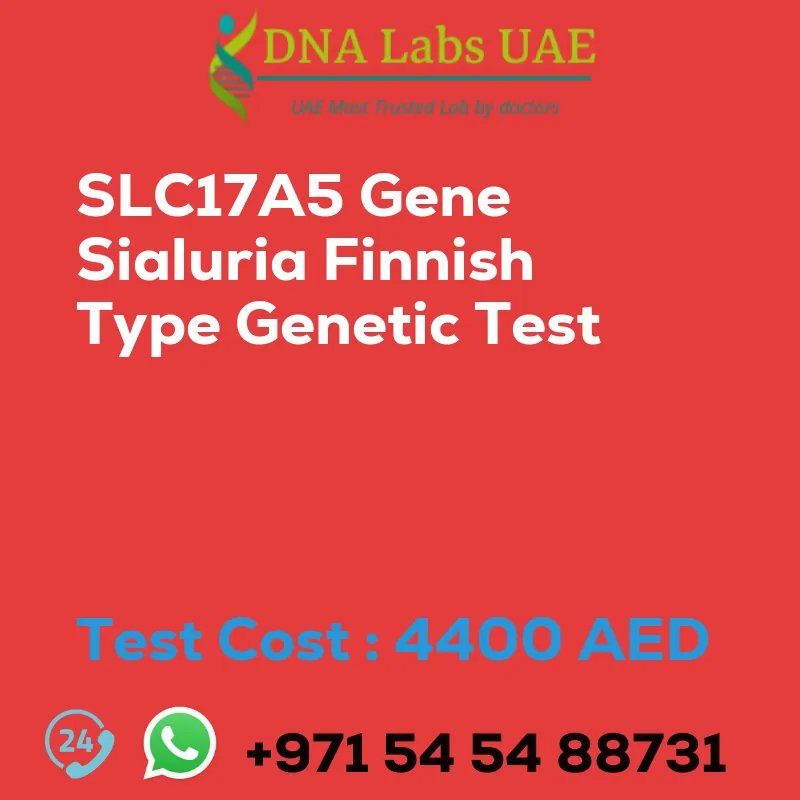SLC17A5 Gene Sialuria Genetic Test
Introduction
SLC17A5 gene sialuria is a rare genetic disorder characterized by the accumulation of sialic acid in the urine. It is caused by mutations in the SLC17A5 gene, which encodes a protein called sialin that is responsible for transporting sialic acid out of cells.
Test Details
To diagnose SLC17A5 gene sialuria, a next-generation sequencing (NGS) genetic test can be performed. This type of test allows for the simultaneous analysis of multiple genes, including the SLC17A5 gene, to identify any mutations or variations that may be present.
Test Name:
SLC17A5 Gene Sialuria finish type Genetic Test
Components:
Price: 4400.0 AED
Sample Condition:
Blood or Extracted DNA or One drop Blood on FTA Card
Report Delivery:
3 to 4 Weeks
Method:
NGS Technology
Test Type:
Neurological Disorders
Doctor:
Neurologist
Test Department:
Genetics
Pre Test Information:
Clinical History of Patient who is going for SLC17A5 Gene Sialuria, finish type NGS Genetic DNA Test A Genetic Counselling session to draw a pedigree chart of family members affected with SLC17A5 Gene Sialuria, finish type
Test Procedure
- Sample collection: A small sample of blood or saliva is collected from the patient. In some cases, a skin biopsy may be required to obtain a sample of skin cells.
- DNA extraction: The genetic material (DNA) is extracted from the collected sample. This DNA contains the patient’s genetic information, including the SLC17A5 gene.
- Library preparation: The extracted DNA is prepared for sequencing by creating a DNA library. This involves fragmenting the DNA and attaching specific DNA sequences, called adapters, to the fragments. These adapters allow for the amplification and sequencing of the DNA.
- Sequencing: The prepared DNA library is loaded onto a next-generation sequencing platform, such as Illumina or Ion Torrent. The platform then performs the sequencing process, which generates millions of short DNA sequences.
- Data analysis: The generated DNA sequences are analyzed using bioinformatics tools and compared to a reference genome. This analysis identifies any variations or mutations in the SLC17A5 gene that may be present in the patient’s DNA.
- Interpretation and reporting: The results of the NGS genetic test are interpreted by a geneticist or genetic counselor. Any identified mutations or variations in the SLC17A5 gene are reported to the healthcare provider, who can then discuss the results with the patient and provide appropriate recommendations for further management or treatment.
Conclusion
A NGS genetic test for SLC17A5 gene sialuria involves the analysis of the SLC17A5 gene using next-generation sequencing technology. This test helps diagnose the condition by identifying any mutations or variations in the gene that may be responsible for the disorder.
| Test Name | SLC17A5 Gene Sialuria finish type Genetic Test |
|---|---|
| Components | |
| Price | 4400.0 AED |
| Sample Condition | Blood or Extracted DNA or One drop Blood on FTA Card o |
| Report Delivery | 3 to 4 Weeks |
| Method | NGS Technology |
| Test type | Neurological Disorders |
| Doctor | Neurologist |
| Test Department: | Genetics |
| Pre Test Information | Clinical History of Patient who is going for SLC17A5 Gene Sialuria, finish type NGS Genetic DNA Test A Genetic Counselling session to draw a pedigree chart of family members affected with SLC17A5 Gene Sialuria, finish type |
| Test Details |
SLC17A5 gene sialuria is a rare genetic disorder characterized by the accumulation of sialic acid in the urine. It is caused by mutations in the SLC17A5 gene, which encodes a protein called sialin that is responsible for transporting sialic acid out of cells. To diagnose SLC17A5 gene sialuria, a next-generation sequencing (NGS) genetic test can be performed. This type of test allows for the simultaneous analysis of multiple genes, including the SLC17A5 gene, to identify any mutations or variations that may be present. The NGS genetic test for SLC17A5 gene sialuria typically involves the following steps: 1. Sample collection: A small sample of blood or saliva is collected from the patient. In some cases, a skin biopsy may be required to obtain a sample of skin cells. 2. DNA extraction: The genetic material (DNA) is extracted from the collected sample. This DNA contains the patient’s genetic information, including the SLC17A5 gene. 3. Library preparation: The extracted DNA is prepared for sequencing by creating a DNA library. This involves fragmenting the DNA and attaching specific DNA sequences, called adapters, to the fragments. These adapters allow for the amplification and sequencing of the DNA. 4. Sequencing: The prepared DNA library is loaded onto a next-generation sequencing platform, such as Illumina or Ion Torrent. The platform then performs the sequencing process, which generates millions of short DNA sequences. 5. Data analysis: The generated DNA sequences are analyzed using bioinformatics tools and compared to a reference genome. This analysis identifies any variations or mutations in the SLC17A5 gene that may be present in the patient’s DNA. 6. Interpretation and reporting: The results of the NGS genetic test are interpreted by a geneticist or genetic counselor. Any identified mutations or variations in the SLC17A5 gene are reported to the healthcare provider, who can then discuss the results with the patient and provide appropriate recommendations for further management or treatment. In conclusion, a NGS genetic test for SLC17A5 gene sialuria involves the analysis of the SLC17A5 gene using next-generation sequencing technology. This test helps diagnose the condition by identifying any mutations or variations in the gene that may be responsible for the disorder. |








